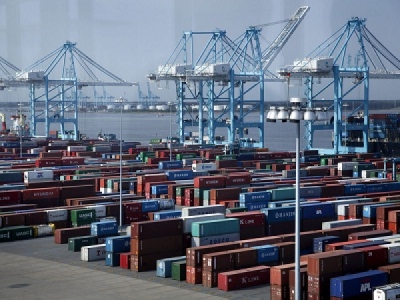
Posted on October 3, 2017
By Alex Perry, Suffolk News-Herald
An approved expansion for a spit of land visible by drivers crossing the Monitor-Merrimac Memorial Bridge-Tunnel will support growth at the Port of Virginia.
The Office of Management and Budget approved a $3-million request from the U.S. Army Corps of Engineers Norfolk District on Wednesday. These funds will go toward the Craney Island Eastward Expansion Project, a civil works effort to expand the Craney Island Disposal Management area.
Congressmen Bobby Scott and Scott Taylor had collaborated with OMB to get the project approved. In the press release, Taylor cited the statewide benefits, including those at its port.
“The Port of Virginia is not only a hub of international commerce or a key factor in our military’s readiness,” Taylor stated, “It is a vital asset for Virginia.”
The U.S. Army Corps of Engineers owns the island and uses it for depositing dredge material from harbor projects. The expansion project is the largest fully-permitted port expansion project on the East Coast, allowing for a future marine terminal to handle ultra-large container vessels, according to the port website.
The port will match federal investments to construct the eastward expansion in phases over decades so the land is available when needed.
“It’s a wonderful opportunity for long-term strategic planning and growth,” said John Reinhart, Virginia Port Authority chief executive officer and executive director.
Additionally, Scott and Taylor joined port, Corps of Engineers and other military officials at an annual summit on Sept. 19.
The annual meeting was an update on a plan approved by the Corps to dredge the main shipping channels from 50 to 55 feet and widen them from 1,000 to 1,200 feet. Other channels could be dredged as deep as 59 feet.
This project is estimated to cost between $266 million and $324 million, split evenly between state and federal financing. A simultaneous, independent project would deepen sections of the Southern Branch of the Elizabeth River from a range of 35 and 40 feet, to about 38 and 45 feet.
Both projects will be reviewed by Corps’ of Engineers before seeking federal and state financing.
“We’re moving well down the path to bring this forward, “Reinhart said.
He said the plan is to prepare for the bigger ships on the horizon and to make Virginia the most attractive East Coast option for port users.
The port was called on by the CMA CGM Theodore Roosevelt on Aug. 28, the largest ship ever to call the U.S. East Coast at 14,400 twenty-foot equivalent units. Its twin, the John Adams, called on Sept. 6.
Reinhart said the global economy is fairly stable, with steady trade moving in and out of the U.S. At the same time, ports across the country and the world are preparing for bigger and fewer ships that reduce the cost of fuel, labor and transit.
“Our ship visits are down 10 percent, but our volume is up seven-and-a-half percent,” Reinhart said. “That shows you’re getting more activity per vessel call.”
Companies have recognized this and positioned themselves close to the port. Emser Tile, a California-based supplier, opened a warehouse and distribution center in August at CenterPoint Intermodal Center in Suffolk, a decision that was influenced by the success of the port, Reinhart said.
“The magnet is getting stronger, the attraction is getting bigger, and the name of Virginia is getting bigger around the world,” he said. “That means good things for Hampton Roads and Suffolk in particular.”
Source: Suffolk News-Herald





